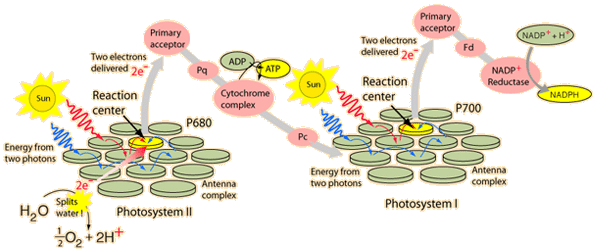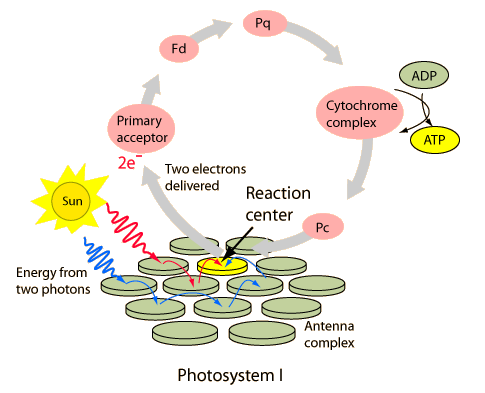


Flower
POWER
Light Dependent Reactions
Non-Cyclic Electron Flow
Non-cyclic electron flow, the predominant route, produces both ATP and NADPH.
1. Photosystem 2 absorbs a photon of light. One of the electrons of P680 is excited to a higher energy state.
2. This electron is captured by the primary electron acceptor, leaving the reaction center oxidized.
3. An enzyme extracts electrons from water and supplies them to the oxidized reaction center. This reaction splits water into two hydrogen ions and an oxygen atom that combines with another oxygen atom to form O2.
4. Photoexcited electrons pass along an electron transport chain before ending up at an oxidized photosystem I reaction center.
5. As these electrons “fall” to a lower energy level, their energy is harnessed to produce ATP.
6. Meanwhile, light energy has excited an electron of PS I’s P700 reaction center. The photoexcited electron was captured by PS I’s primary electron acceptor, creating an electron “hole” in P700. This hole is filled by an electron that reaches the bottom of the electron transport chain from PS II.
7. Photoexcited electrons are passed from PS I’s primary electron acceptor down a second electron transport chain through the protein ferredoxin (Fd).
8. The enzyme NADP+ reductase transfers electrons from Fd to NADP+. Two electrons are required for NADP+’s reduction to NADPH. NADPH will carry the reducing power of these high-energy electrons to the Calvin cycle.
The light reactions use the solar power of photons absorbed by both photosystem I and photosystem II to provide chemical energy in the form of ATP and reducing power in the form of the electrons carried by NADPH.
Cyclic Electron Flow
Under certain conditions, photoexcited electrons from photosystem 1, but not photosystem 2, can take an alternative pathway, cyclic electron flow. Cyclic electron flow is the simplest pathway, but involves only photosystem 1 and generates ATP without producing NADPH or involving oxygen.
It is cyclic because excited electrons that leave from chlorophyll a at the reaction center return to the reaction center.
As photons are absorbed by Photosystem I, the P700 reaction center chlorophyll releases excited-state electrons to the primary electron acceptor; which, in turn, passes them to ferredoxin. From there the electrons take an alternate path that sends them tumbling down the electron transport chain to P700. This is the same electron transport chain used in noncyclic electron flow.
With each redox reaction along the electron transport chain, electrons lose potential energy until they return to their ground-state orbital in the P700 reaction center. The exergonic flow of electrons is coupled to ATP production by the process of chemiosmosis. This process of ATP production is called cyclic photophosphorylation.
Absorption of another two photons of light by the pigments send a second pair of electrons through the cyclic pathway.
The function of the cyclic pathway is to produce additional ATP. It does so without the production of NADPH or O2.
Cyclic photophosphorylation supplements the ATP supply required for the Calvin cycle and other metabolic pathways. The noncyclic pathway produces approximately equal amounts of ATP and NADPH, which is not enough ATP to meet demand.
NADPH concentration might influence whether electrons flow through cyclic or noncyclic pathways.
This occurs when cells may require additional ATP, or when there is no NADP+ to reduce to NADPH. In photosystem 2, the pumping to H ions into the thylakoid and the conversion of ADP + P into ATP is driven by electron gradients established in the thylakoid membrane.
Calvin Cycle
The Calvin cycle uses the chemical energy of ATP and NADPH to reduce CO2 to sugar. The Calvin cycle regenerates its starting material after molecules enter and leave the cycle. The cycle builds sugar from smaller molecules by using ATP and the reducing power of electrons carried by NADPH.
There are three phases of RuBP (Ribulose bisphosphate pathway) and three unique enzymes found only operating in the cycle. The three phases of the cycle are carboxylation, reduction, and regeneration.
Carboxylation: CO2 is combined with ribulose bisphosphate, a 5 carbon compound, that immediately splits to form two 3-phosphoglycerate molecules (3 carbon compounds). The enzyme that catalyzes the reaction is ribulose bisphosphate carboxylase and it is the most abundant enzyme on earth. The rest of RuBP has two goals. To create fructose, that is siphoned off for cellular metabolism and to regenerate the ribulose bisphosphate molecule, for another turn of the cycle.
Reduction: In this phase, the two 3-phosphoglycerate molecules are reduced, using ATP and NADPH to glyceraldehyde-3-phosphate (an intermediate in glycolysis). One of the glyceraldehyde-3-phosphatase is then converted to dihydroxyacetone phosphate. Next the glycolytic enzyme aldolase is used in reverse combining glyceraldehyde-3-phosphate and dihydroxyacetone phosphate to form fructose-1, 6-bisphosphate. Finally, this is converted into Fructose-6-phosphate.
Regeneration: The rest of the steps of RuBP involve reforming the ribulose bisphosphate. Regeneration involves a complex series of reactions and two enzymes unique to the RuBP are important in the process. One ATP is expended to generate Ribulose bisphosphate.
Energy Balance of RuBP
To generate one extra fructose-6-phosphate molecule that can be removed from the cycle, six ribulose bisphosphate molecules have to be carboxylated. Six ribulose bisphosphate split into twelve 3-phosphoglycerate molecules and reduction of them to glyceraldehyde-3-phosphate costs 12 ATP and 12 NADPH. Adding in the six ATP to regenerate ribulose bisphosphate brings the total cost of synthesizing 1 fructose to 18 ATP and 12 NADPH. The take home message is, CO2 fixation is an expensive process!
To make a molecule of glucose requires 6 turns of the cycle.
Eighteen molecules of ATP will be dephosphorylated and 12 molecules of NADPH will be oxidized. Each molecule of NADPH can be considered to be roughly equivalent to 3 molecules of ATP in terms of energy. So, it requires approximately the equivalent of 54 ATPs to make a molecule of glucose.
( 3 x 12 NADPH = 36 ATP)
(36 ATP + 18 ATP = 54 ATP)


